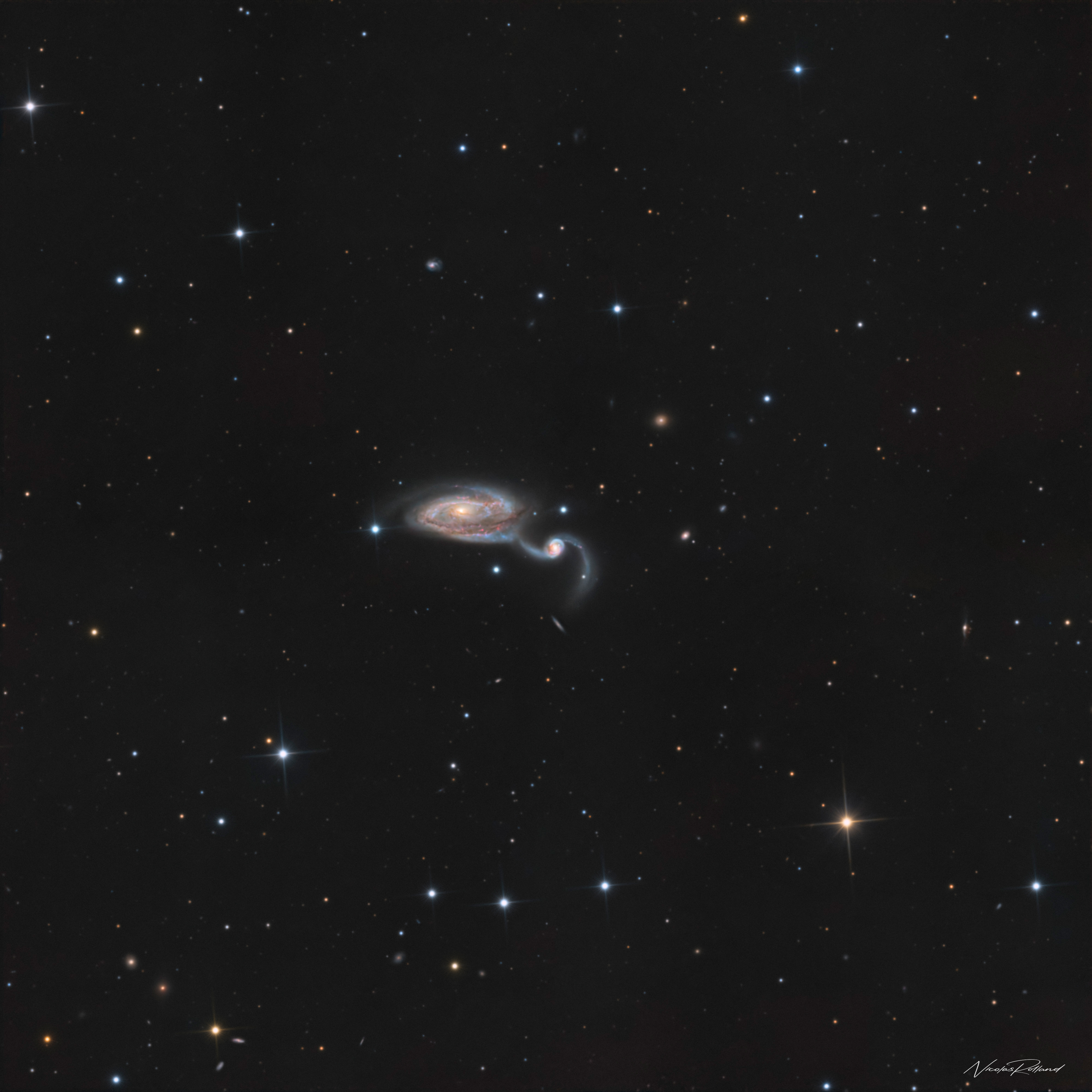The Heron Galaxy
Arp 84
Deep in the constellation Canes Venatici, about 160 million light-years from Earth, an extraordinary cosmic ballet unfolds. Arp 84 - a mesmerizing pair of interacting galaxies catalogued as NGC 5394 and NGC 5395, where gravitational forces have choreographed one of the universe's most elegant performances.
A Tale of Two Galaxies
The larger galaxy, NGC 5395, stretches approximately 140,000 light-years across. Its companion, the smaller NGC 5394, measures about 90,000 light-years in diameter. What makes this pair truly spectacular isn't just their individual beauty, but the dramatic story written in their distorted shapes.
As these cosmic neighbors orbit each other, their immense gravitational fields pull and stretch their spiral arms into sweeping tidal tails. The smaller galaxy appears almost to be reaching out with a graceful arm toward its larger companion, creating the distinctive features that earned this system a place in Halton Arp's Atlas of Peculiar Galaxies.
Gravity's Masterpiece
The interaction between NGC 5394 and NGC 5395 began hundreds of millions of years ago, when they first ventured close enough for gravity to take hold. This cosmic encounter has triggered intense star formation in both galaxies, visible as bright blue regions scattered throughout their spiral arms. The gravitational dance has also sculpted dramatic dust lanes that snake through their structures, creating the intricate patterns we observe today.
Computer simulations suggest these galaxies are currently at their closest approach, with NGC 5394 possibly having already passed behind its larger partner. The tidal forces generated during this encounter have not only distorted their shapes but also funneled gas toward their central regions, potentially feeding the supermassive black holes lurking at their cores.
A Window into Galactic Evolution
Arp 84 offers astronomers a front-row seat to understand how galaxies evolve through interactions. These cosmic collisions are far from destructive - they're creative processes that trigger star birth, redistribute matter, and ultimately reshape galactic architecture. In a few billion years, these two galaxies may merge completely, forming a single elliptical galaxy enriched by their shared stellar populations.
The system also provides insights into the role of dark matter in galactic interactions. While we can't see it directly, dark matter's gravitational influence helps explain the extended tidal features and the orbital dynamics of this celestial pair.
To capture this image, a Planewave CDK17 telescope (432mm) was used, paired with a FLI Kepler 4040 CMOS camera and Astrodon Deep-Sky LRGB filters. Due to the galaxies' faint luminosity, long exposures were necessary to collect sufficient light. A total of 394 frames, amounting to 9.7 hours of exposure, were stacked. Post-processing techniques were applied to adjust contrast and levels, bringing out subtle details such as tidal tails and bright cores.
TECHNICAL DATA
ACQUISITION DETAILS
OPTICS Planewave CDK17 @ F/6.8
CAMERA FLI Kepler 4040fi BIS CMOS
MOUNT Planewave L-500
FILTERS L, R, G, B
LOCATION Apollo 11 Observatory, Fregenal de la Sierra, Badajoz Extremadura, Spain
DATE October 2024
EXPOSURES 9.7 hours (L: 205*60s, R: 60*120s, G: 69*120s, B: 60*120s)
PROCESSING SOFTWARE Pixinsight, Photoshop
COPYRIGHTS Nicolas Rolland & Roboscope

TARGET DETAILS
RA 12h 59m 33.9s
DEC +37° 27' 02.2"
SIZE 20.9 x 20.9 arcmin
PIXEL SCALE 0.314 arcsec/pixel
ORIENTATION Up is 274.8 degrees E of N
CONSTELLATION Canes Venatici
MAGNITUDE 11.4
DISTANCE 160 million ly
NUMBER OF GALAXIES 2 interacting spiral galaxies
